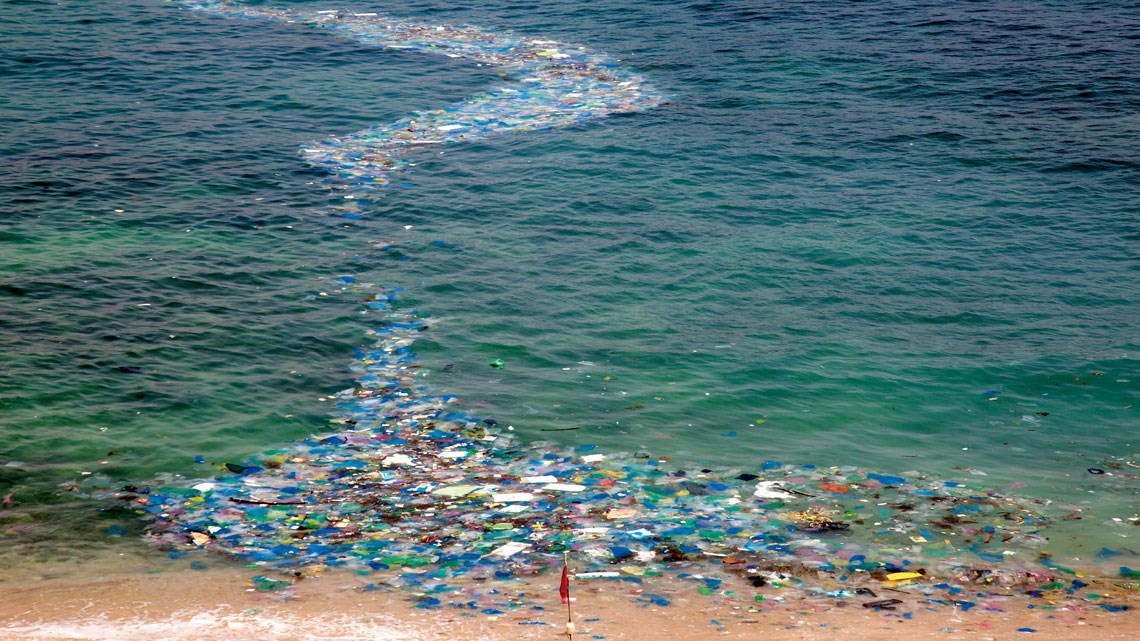From the large piles of trash visible on the surface to the depths of the ocean floor, plastic is everywhere in the marine environment. The total volume of plastic in its numerous shapes, compositions, and sizes is estimated at between 86 million and 150 million tons (t) worldwide, which could take centuries to decompose. Brazil alone potentially discards 3.44 million tons of plastic bags, bottles, straws, shampoo containers, and polystyrene into the environment every year, according to a recent study by the Blue Keepers project, part of the United Nations (UN) Global Compact in Brazil. Since plastic is a relatively recent invention, only becoming popular after World War II (1939–1945) and rising in use from the 1970s onwards, many of its effects on organisms and ecosystems are still unknown, especially the impacts of small particles. A robust body of evidence, however, suggests that it has major and serious consequences.
– The trash trail to the sea
Marine plastic pollution was discussed at the 2022 UN Ocean Conference held in Lisbon at the end of June. Experts highlighted the link to climate change—4.5% of carbon emissions are related to plastic production and disposal, partly because waste dumped into the sea decomposes so slowly. “Our oceans are in a critical state and numerous, urgent, and collective actions are needed,” said Sweden’s Secretary of State for Climate Change and the Environment, Anders Grönvall, at the opening of an event at the conference that addressed innovations for combating this type of pollution. “We cannot ignore that most marine litter is plastic. Eighty percent of plastic waste found in the ocean originates from land and the total volume is projected to triple by 2040 unless we take significant action.”
The UN has named 2021–2030 as the Decade of Ocean Science for Sustainable Development, also known as Ocean Decade. While plastic pollution is the greatest concern, marine environments are also impacted by other pollutants, such as oil spills, mining tailings, and untreated domestic and industrial sewage.
Earlier this year, international nongovernmental organization (NGO) the WWF published a report by the Alfred Wegener Institute, Helmholtz Center for Polar and Marine Research in Germany that presented a disappointing conclusion. Even if all plastic pollution ceased today, the level of microplastics in the oceans (see Pesquisa FAPESP issue nº 281)—no more than 5 millimeters (mm) in size—would double by 2050. This is because microplastics are created when larger plastics that already exist in the environment break down into smaller and smaller pieces, without their main structure being altered. The report reviewed 2,592 scientific studies on the impact of this type of pollution on marine species, biodiversity, and ecosystems. Dozens of the articles cited were authored by Brazilian scientists.
“At certain times of the year there is more microplastic suspended in the water along with the plankton than fish larvae,” says marine ecologist Mário Barletta of the Federal University of Pernambuco (UFPE), author of at least 10 papers mentioned in the report. A specialist in estuary ecology, Barletta investigates the transitional aquatic environment between the Goiana River in the state of Pernambuco and the sea. “I use this estuary as a reference to explain the phenomenon in tropical estuaries. The area is very well preserved.”
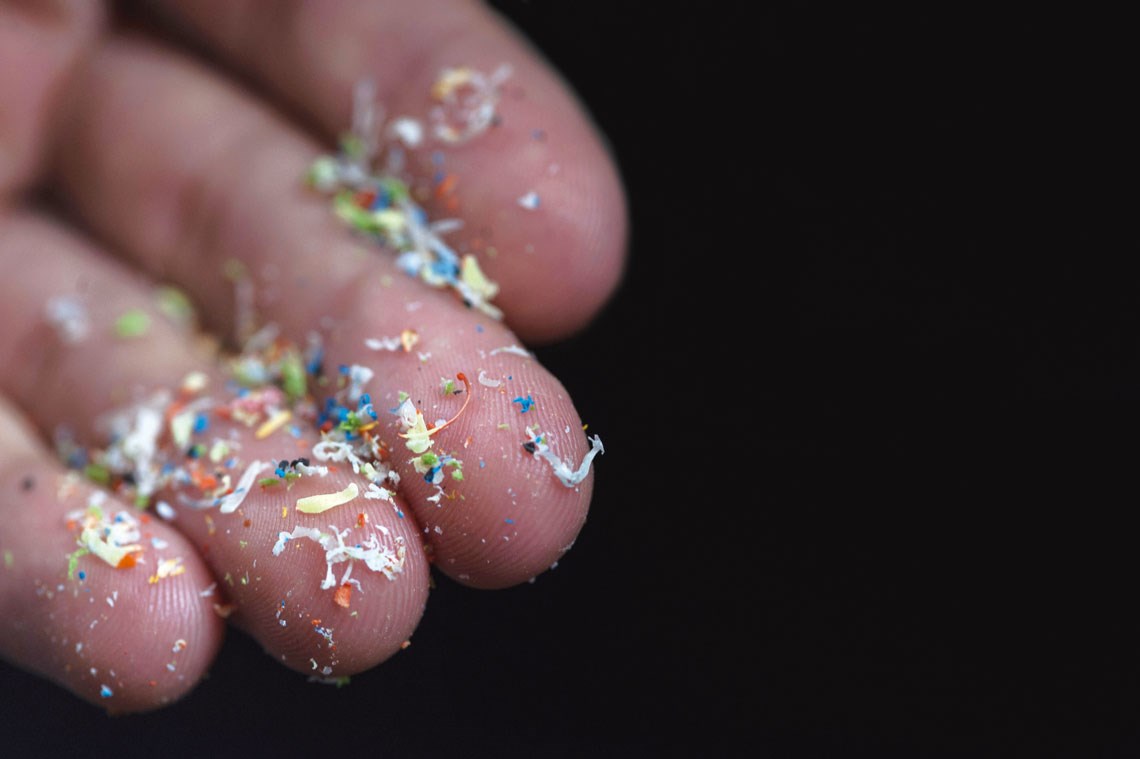
Léo Ramos Chaves / Revista Pesquisa FAPESPOver time, plastic in the sea degrades into smaller and smaller fragmentsLéo Ramos Chaves / Revista Pesquisa FAPESP
One of his articles, published in the journal Science of the Total Environment in 2019, describes how microplastic contamination is transferred within the food web based on material found in the stomach of sea bass. The sequence of organisms that serve as food for one another in a given ecosystem (“who eats who”) is called a food chain. The interaction of various food chains within an ecosystem is called a food web.
“We found one prey type that was very well preserved inside the fish, and when we opened up this prey, there was microplastic inside. This finding suggests that top predators, such as sea bass and hake, are being contaminated not only with microplastic from the environment, but also via their prey, which are already contaminated when they eat them. This is something much more serious.”
Some scientists have proposed using certain marine animals, such as mussels and oysters, as bioindicators of environmental quality and the possible risks posed by plastic to human food security. “These animals are filter feeders. They have special structures that filters food particles out of sea water for them to eat. They also end up consuming plastic, which stays inside them for a period of time. We can use this as an indirect indicator of what is in the environment,” explains biologist Alexander Turra of the Oceanographic Institute at the University of São Paulo (USP) and coordinator of the UNESCO chair for Ocean Sustainability.
One of the articles of which Turra is a coauthor was the result of an international collaboration with researchers from China, Norway, and other countries, who together collected bivalve mollusks from the wild and from food markets to assess them for this possible dual purpose (as an environmental bioindicator and regarding food security). “We are working on six sub-projects in various locations, including the Paraná and São Paulo coastlines, Australia, and the Atlantic and Pacific oceans.” The latter is carried out in partnership with the Schurmann family’s Voz dos Oceanos initiative and is funded by the UN Environment Program (UNEP). Passionate about the ocean, the Schurmanns are a family of Brazilian sailors who are currently circumnavigating the world on a sailboat for the fourth time.
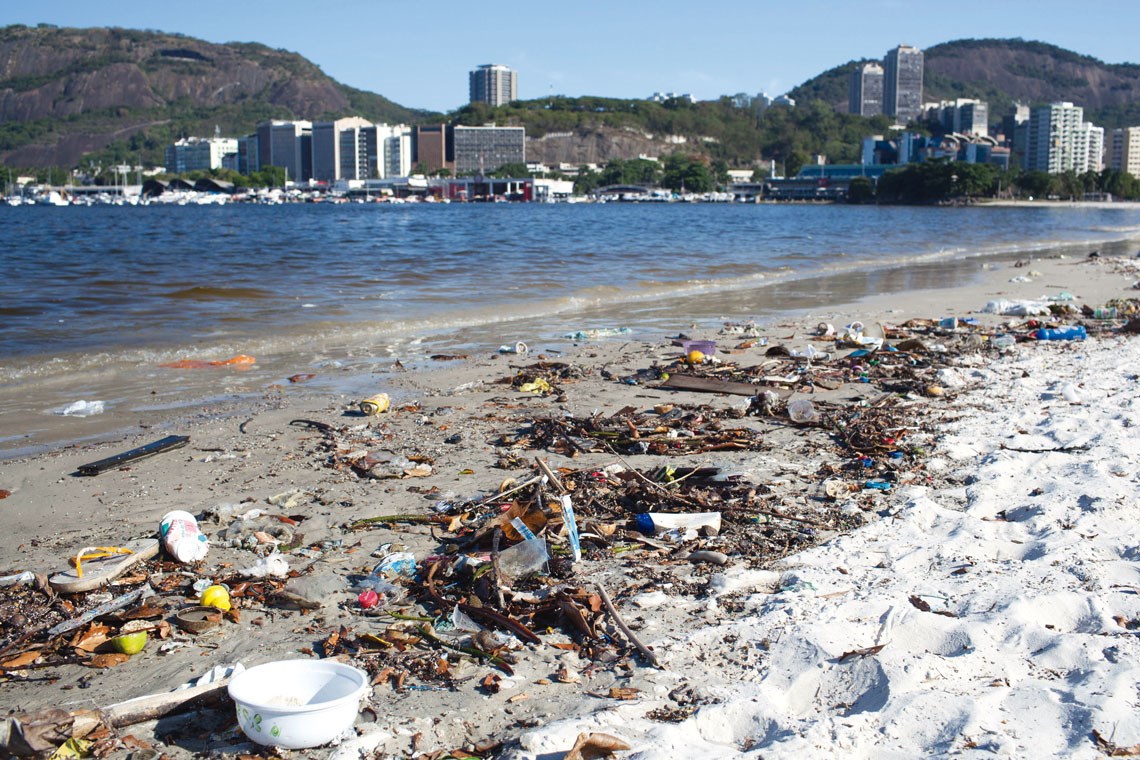
Phil Clarke Hill / Corbis via Getty ImagesPlastic bowls, bottles, and bags pollute Botafogo beach in Rio de JaneiroPhil Clarke Hill / Corbis via Getty Images
In addition to the number of items, the researchers record the type and origin of the material inside these organisms. “At the bottom of Paranaguá Bay in Paraná we found a lot of degraded vehicle tire waste, which comes from trucks driving along the Estrada da Graciosa highway in the Serra do Mar. This fingerprint of the types and amounts of plastic varies from place to place,” explains Turra. In São Paulo, he says, there are many more fibers associated with synthetic clothes, which break away during washing and end up in the sea due to the low collection coverage and inefficient sewage treatment.
Coastal areas, however, are not home to the highest volume of microplastic particles—although they do have the highest number of items larger than 5 mm, which according to some classifications should be categorized as macroplastics. According to the studies cited in the WWF report, there may be even more waste on the sea floor than in the great ocean gyres, where major currents bring together enormous floating patches of garbage. Almost nothing is known about the distribution and concentration of nanoplastics—fragments smaller than 0.1 micrometer (equivalent to one thousandth of a mm), which are invisible to the naked eye and capable of entering the bloodstream.
For slightly larger plastics, scientists suggest observing a range of animals as indicators of pollution. In an article published in the journal Ecological Indicators in 2016, biologist Leonardo Lopes Costa of the State University of Northern Rio de Janeiro (UENF) and his colleagues claim that nests made by the brown booby (Sula leucogaster) can serve this purpose. Of the nests analyzed in two sets of islands in Arraial do Cabo and Macaé in the north of Rio de Janeiro, 61% contained garbage that reflected the amount of plastic and fishing material in the surrounding waters. “We know that these birds use plastic as a nesting material [to build their nests], but we still do not know the consequences of this for the chicks and adults. We also don’t know if it has another function, such as in reproductive courting,” says Costa.
The UENF researcher also identified another unusual way plastic is used by marine animals on the beaches of southeast Brazil, where he found that the Atlantic ghost crab (Ocypode quadrata) purposely places fragments of the material in its burrows, especially the most malleable types, such as straws, strings, and sponges. “We saw that occupancy rates were more than twice as high in burrows containing plastic litter than in those that did not. Burrows without garbage had generally been abandoned by the crabs. Our hypothesis, which still needs to be tested, is that plastic is used as a location marker by these invertebrates, since some studies suggest that this species prefers to continue using the same burrows. This behavior is called homing.”
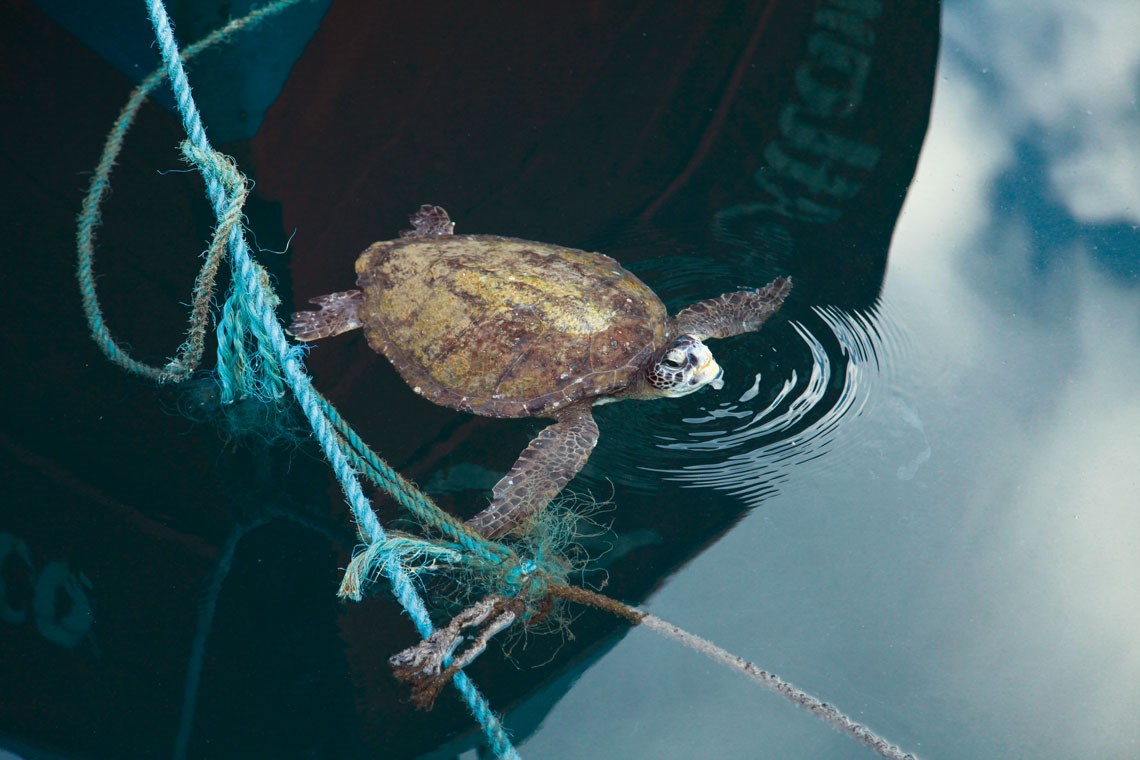
Fabio ColombiniRopes, bags, and other garbage discarded on land impact marine animal welfareFabio Colombini
Although interactions between marine species and plastics do not always have negative consequences, many scientists are investigating the harmful effects on animals and organisms, which include injuries or death, reduced mobility, dietary changes, and altered cell functions. One major negative impact of plastic occurs upon ingestion. The material can block digestive systems, cause internal damage, and create a false sense of being satiated, altering or reducing feeding habits and thereby negatively impacting growth, immune response, fertility, and reproduction.
Gustavo Rodamilans de Macedo, a doctor of tropical animal science and head of the Humpback Whale Project in Bahia, performed autopsies on 45 sea turtles found dead on the north coast of Bahia in 2006 and 2007 and published an article describing that litter—mainly from fishing—was found inside 60% of them.
“For turtles, ingesting waste such as plastic bags, bottle caps, wax, or pieces of fishing rope can cause compaction, stomach perforation, ulcers, and accumulation of gas. This is the type of interaction we see the most, especially in green sea turtles [Chelonia mydas], which feed on algae. There is a lot of garbage around the algae they eat,” says the veterinarian, who has worked for the sea turtle conservation project TAMAR for more than 15 years. “I proved in my study that the entire digestive tract needs to be analyzed to determine whether an animal has interacted with garbage. Statistically, if I take a turtle and just look at its stomach and esophagus, I cannot say anything for sure. Most of the time, the plastic is in the large intestine.”
Robson Henrique de Carvalho, a biologist with a PhD in ecology from the Federal University of Juiz de Fora (UFJF), also published an article on the ingestion of garbage by sea turtles, but on the coast of Rio de Janeiro. In his study, 39% of 23 animals from five different species found dead or dying on the beaches of Búzios and Cabo Frio in 2011 had marine litter in their bodies.
Carvalho and his colleagues estimate that waste ingestion is the main cause of death for many sea turtles in the country, but they stress that more studies are needed. “Various scientists, institutes, and even companies that monitor beaches perform animal autopsies to look for garbage in the digestive tract, but in general these data are not published. We have plenty of data, but so little is published in scientific journals.”
The researchers point out that it is important to identify and analyze data on plastic waste in order to identify the origin and consequences of the problem and thus contribute to relevant public policies. “This is a complex problem with various sources and many complementary ways to act,” points out Turra. “We will only be successful if the different actors in society work together and create the conditions needed to transform the planet into one without garbage in the sea.”
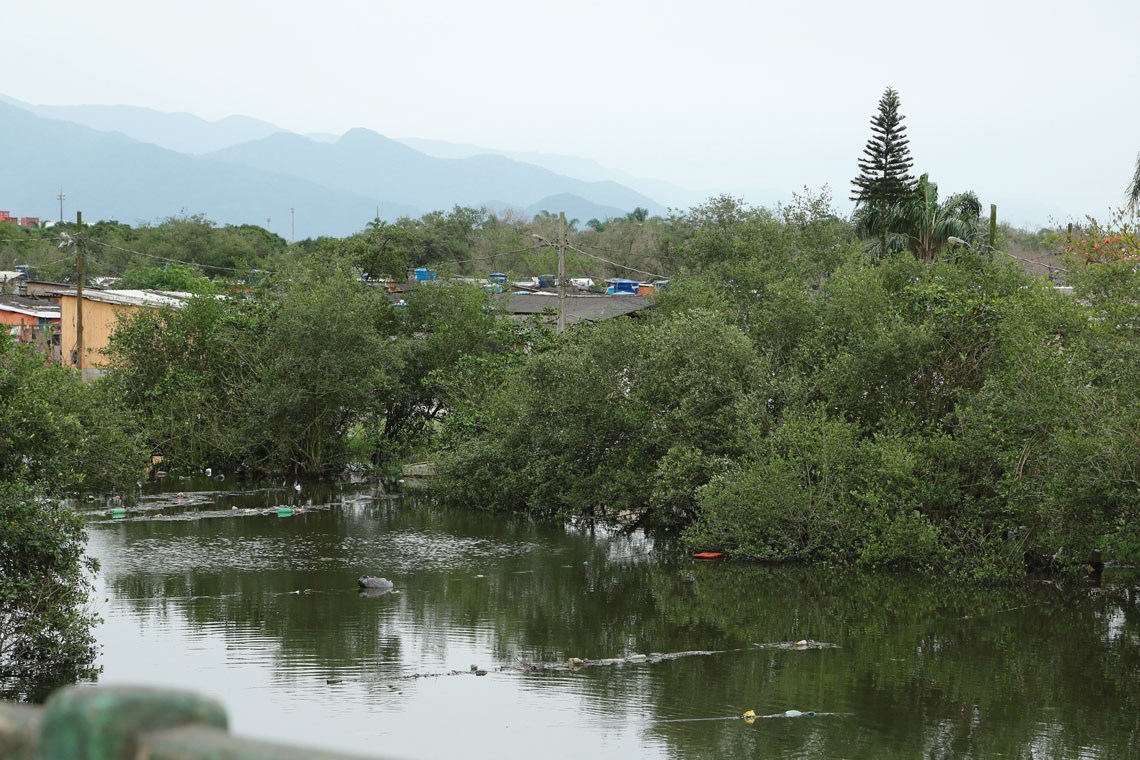
Fabio ColombiniMangrove in Guarujá, on the coast of São Paulo: ecosystem at riskFabio Colombini
According to the scientist, although Brazil’s Ministry of the Environment is not fulfilling its duty of coordinating this effort in the country, some states are working hard to fill the gap. “São Paulo has already internalized the issue of ocean litter through state public policies and is working to combat the problem,” highlights Turra. The Oceanographic Institute at USP, in partnership with the São Paulo State Infrastructure and Environment Department, the Brazilian Biodiversity Fund (FUNBIO), and the Norwegian embassy, is implementing the Strategic Plan for Monitoring and Evaluating Ocean Litter (PEMALM). “One of the plan’s goals is to generate indicators so that we can better understand the problem and monitor progress. The other is to undertake actions based on the different fronts on which the State can operate.”
The PEMALM team, who started work in São Paulo in January this year, feeds the indicators platform with data related to waste generation, waste management, recycling volume, amount of waste found on beaches and in other marine environments, and the economic and ecological effects. Another five Brazilian states are planning to adopt the same approach: Amapá, Ceará, Bahia, Rio de Janeiro, and Paraná.
Coral reefs and mangroves are among the key ecosystems most at risk from plastics, warn the researchers. Both provide vital services to the planet, including maintaining fish reproductivity and biodiversity. An article published in the journal Marine Pollution Bulletin in 2010 described the results of a survey of eight mangroves in São Vicente on the São Paulo coast.
“We used the same sampling method for the garbage as is used to measure living organisms and plant density,” says Tânia Marcia Costa, a biologist from the Institute of Biosciences at São Paulo State University (UNESP), Litoral Paulista campus. “In terms of density per square meter, plastic dominates, meaning it takes up more space. When we evaluated the weight [of the solid waste], the result was different, because we found a lot of wood. This is because there is a major slum in the region around the mangrove islands, with many houses built on wooden stilts.” Because wood degrades quickly, it has less of an impact on the environment, the paper states.
Costa points out that it is important to understand the role played by each pollutant in an ecosystem. “Mangrove regions, which are carbon sinks, are characterized by the constant deposition of sediments, with animals feeding on whatever is deposited. Microplastics are therefore a big problem, although macroplastic is also a concern.”
The WWF report highlights that the issue of plastic in the sea should not be considered in isolation. Other man-made threats include ocean warming, overfishing, acidification, habitat destruction and fragmentation, shipping, underwater noise, and other chemical pollutants. The best approach, argues the document—and the Brazilian scientists interviewed agreed—is to prevent plastic waste in the environment by reducing production in general.
Projects
1. Promoting beach conservation and spatial planning through an ecosystemic approach (nº 18/19776-2); Grant Mechanism Biota Program; Principal Investigator Alexander Turra (USP); Investment R$243,097.61.
2. Improving microplastics biomonitoring at beaches through field and laboratory approaches: Effects of short-term variability on monitoring program designs (nº 22/01345-02); Grant Mechanism Doctoral Fellowship Abroad; Supervisor Alexander Turra (USP); Beneficiary Marília Nagata Ragagnin; Investment R$118,482.42.
Scientific articles
FERREIRA, G. V. B. et al. Use of estuarine resources by top predator fishes. How do ecological patterns affect rates of contamination by microplastics? Science of The Total Environment. vol. 655 pp. 292–304. mar. 10, 2019.
LI, J. et al. Using mussel as a global bioindicator of coastal microplastic pollution. Environmental Pollution. vol. 244 pp. 522–33. jan. 2019.
TAVARES, D. C. et al. Nests of the brown booby (Sula leucogaster) as a potential indicator of tropical ocean pollution by marine debris. Ecological Indicators. vol. 70 pp. 10–4. nov. 2016.
COSTA, L. L. et al. Evidence of marine debris usage by the ghost crab Ocypode quadrata (Fabricius, 1787). Marine Pollution Bulletin. vol. 128 pp. 438–45. mar. 2018.
MACEDO, G. R. et al. Anthropogenic debris ingestion by sea turtles in the Northern coast of Bahia, Brazil. Ciência Rural. pp. 1938–41. nov. 2011.
DE CARVALHO, R. H. et al. Marine debris ingestion by sea turtles (Testudines) on the Brazilian coast: An underestimated threat? Marine Pollution Bulletin. vol. 101 pp. 746–9. dec. 30, 2015.
CORDEIRO, C. A. et al. Evaluation of solid residues removed from a mangrove swamp in the São Vicente Estuary, SP, Brazil. Marine Pollution Bulletin. vol. 60 pp. 1762–7. 2010.


